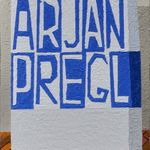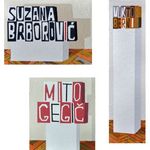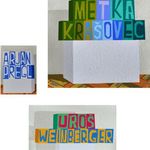Names in Contemporary Slovenian Painting
Arjan Pregl: Names in Contemporary Slovenian Painting
UGM Studio, Trg Leona Štuklja 2, Maribor
opening: Friday, 24 April 2015, at 19:00
"Last year MoMA held an international painting exhibition for the first time in thirty years. Regardless of the globalisation processes, this institution remains the alpha and omega in the world of art and the art market, thus everybody had great expectations as to what it will decide to show and the result was predictable. Even though painting has died a thousand times and it no longer holds the primary position in art, it remains firmly on the market and in artist’s studios. The exhibition resulted in an array of negative and a few positive critiques; it also offered an insight into contemporary painting as seen by MoMA, and provided an extremely important line in the biographies of the exhibited artists.
Painting overview exhibitions are few and far between in Slovenia. The central institution stopped following contemporary painting when Igor Zabel died in 2005. In 2008 Nadja Gnamuš and I curated the exhibition Down the rabbit hole in Ganes Pratt gallery, where we presented paintings that were linked to other media, paintings that entered the room, and paintings in which the painting remained merely as an idea of a painting. In 2012 Božidar Zrinski and myself gathered a selection of artists who used printed medium in painting and presented them in the exhibition We want to be free as the fathers were which was hosted in MGLC. Last year Andrej Medved curated the exhibition First generations after the year zero: From Joni Zakonjšek to Suzana Brborović which was hosted in Cankarjev dom. Each exhibition emphasised a specific view, but did not offer an overview of the entire generation, however some people kept thinking about such an overview, and one of them is Arjan Pregl.
Pregl is a middle generation painter, who has presented his works in large galleries and exhibition spaces across Slovenia, was included in numerous overview exhibitions and selections, exhibited and lived abroad, and he currently writes a regular column for the Ljubljana newspaper Dnevnik.
The project Names in contemporary Slovenian painting became an open studio even before this ‘emerged as an idea’ for this year's Ministry of Culture’s open call. As the project did not fit last year's criteria of the open call it was displayed only this year. Twice. First as it was originally intended, in the artist’s home, and later in an institution, in UGM Studio.
Last year Arjan sent the following question: »If you were making an overview exhibition of Slovenian painting, which artists would you include?« to a selection of Slovenian curators. 18 curators replied. Some failed to reply, but those who replied, came up with the names of 121 painters. Any artist to receive 4 votes or more was placed on the list of selected artists. The highest number of votes a single artist received was 11. Pregl mathematically determined the 20 most often repeated names on the list and depicted each one of them as a sculpture standing on a gallery stand.
The selection, which was made with the use of mathematical formulas and personal preferences supported by expert knowledge, includes 5 female and 15 male painters. All of them are still living, some fresh from the academy, others have been developing their opuses already during modernism. The mathematical cross-section of the 18 experts seems convincing. The final selection seems excellent even though a few art professionals failed to respond, and only a few out of the 18 who responded are specialists for painting. It seems that the mathematical approach is on par with curated exhibitions. At first glance the Names in contemporary Slovenian painting seems similar to 'national' exhibitions – for instance the large exhibition Magic of art, curated by Aleksander Bassin. However, in reality the Names in contemporary Slovenian painting is an original exhibition, which attempts to discover more about the major actors in painting, something that should really be in the domain of experts and institutions. Pregl deliberately avoided doing things in the usual way: his selection process was unusual, as was the exhibition venue and sponsorship as well as his decision to depict names instead of paintings by the chosen artists.
The national key still defines Slovenian art – less and less because of the shared language and culture and more and more because of the poor working conditions that is shared by this community. Pregl painted the names of those who currently form the pinnacle in Slovenian painting. These paintings could be sold in Chelsea, exhibited in Venice or put on offer in Basel. They are a national team that the selectors and coaches cannot send to the best international games due to the lack of funds. Because of this the works of Čerče are not sold in Chelsea, Šuštar’s works cannot be found in Basel and Slovenian artists in general are usually not included in curatorial overviews at the Venetian Biennial - even though many of them have somehow managed to make their way to the presentation in the national pavilion.
Pregl's exhibition does not reveal anything about the works of the artists who are most likely the frontrunners of early 21st century Slovenian art. They remain merely names. We can see images of classic parquet floor and white walls, white gallery stands with characteristic Pregl's letters/cubes that Arjan developed while working on illustrations. The names of the painters on his paintings are empty painting signs, forms that define the shape of the painted sculptures. They remain at home, within the family circle, who lets the world – reporters, critics, art lovers and even neighbours who have seen the flyer for the exhibition in the building lobby – take a peek. Neighbours are Pregl’s favourites for they provide him with an insight as to how familiarity adds or reduces 'weight' to the event and how new communication opportunities arise and are taken advantage of, in a way gallery owners, curators and exhibition organisers usually fail to do.
With the exhibition Pregl publically poses the question that every artist asks, but to which he never receives a convincing reply. He is interested in what forms a painting, what is considered a good contemporary painting and who are the ones creating them. He is interested in the national frame and its relevance and especially in the experts’ opinion as regards this issue. The question was answered by Aleksander Bassin, Matjaž Brulc, Miha Colner, Petja Grafenauer, Ida Hiršenfelder, Pavla Jarc, Milček Komelj, Milena Koren Božiček, Andrej Medved, Saša Nabergoj, Vasja Nagy, Sarival Sosić, Barbara Sterle Vurnik, Maja Škerbot, Simona Vidmar, Milena Zlatar and two other curators who do not wish their names to be revealed. Some failed to reply to the question, while Zdenka Badovinac, Miklavž Komelj, Urša Jurman and Beti Žerovc decided not to cooperate in the project, but responded and explained their decision.
Art is not a competition. However, every selection process establishes a division between the outside and the inside, the included and the excluded. This division is established in a preserved and persistent manner, and Pregl’s project reminds us that it is much more interesting to observe how it moves and in which direction rather than who found himself on which side." (Petja Grafenauer)
Arjan Pregl (b. 1973; Ljubljana) graduated in 1998 at the Academy of Fine Arts and Design in Ljubljana under professors M. Krašovec and B. Gorenc. In 2001 he gained an MA in Fine Arts under professor B Gorenc. The last semester of his MA studies he attended the IUP (Indiana University of Pennsylvania) in USA. Under professor L. Logar he gained an MA in graphics in 2004. Arjan Pregl works in the fields of painting, graphics, illustration and design. He lives and works in Ljubljana.
YOU ARE KINDLY INVITED!
Supported by:






